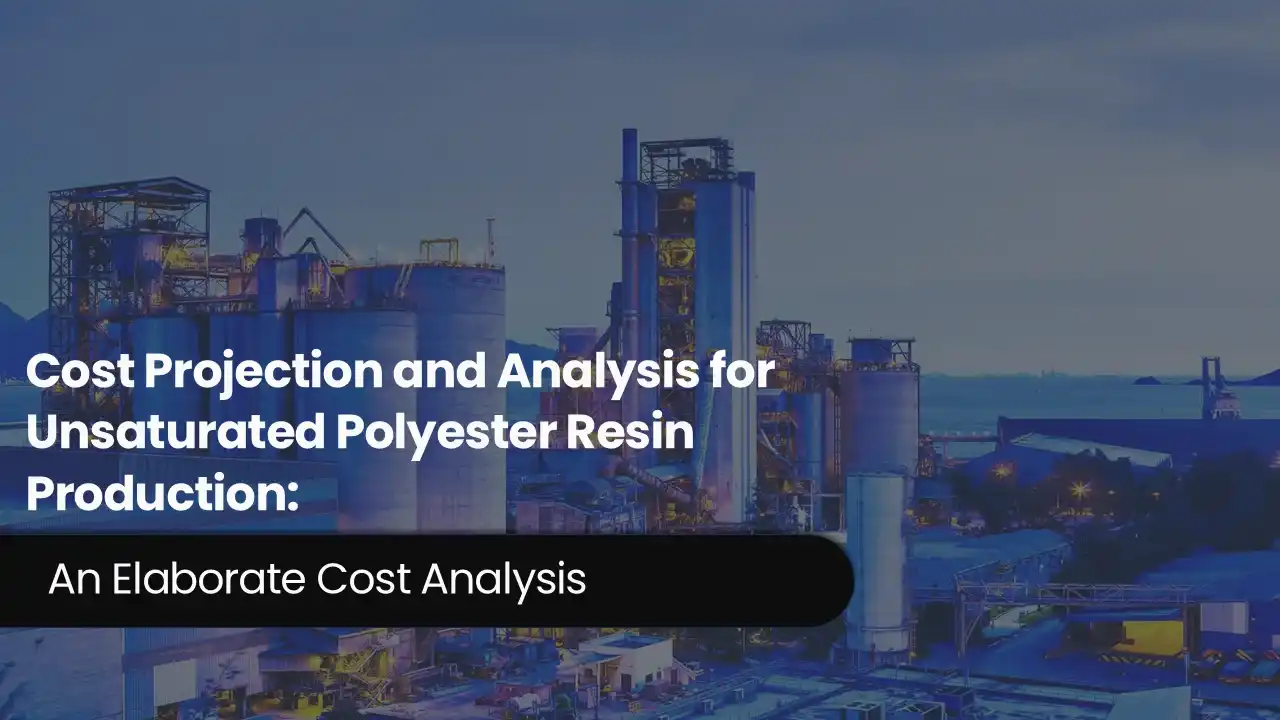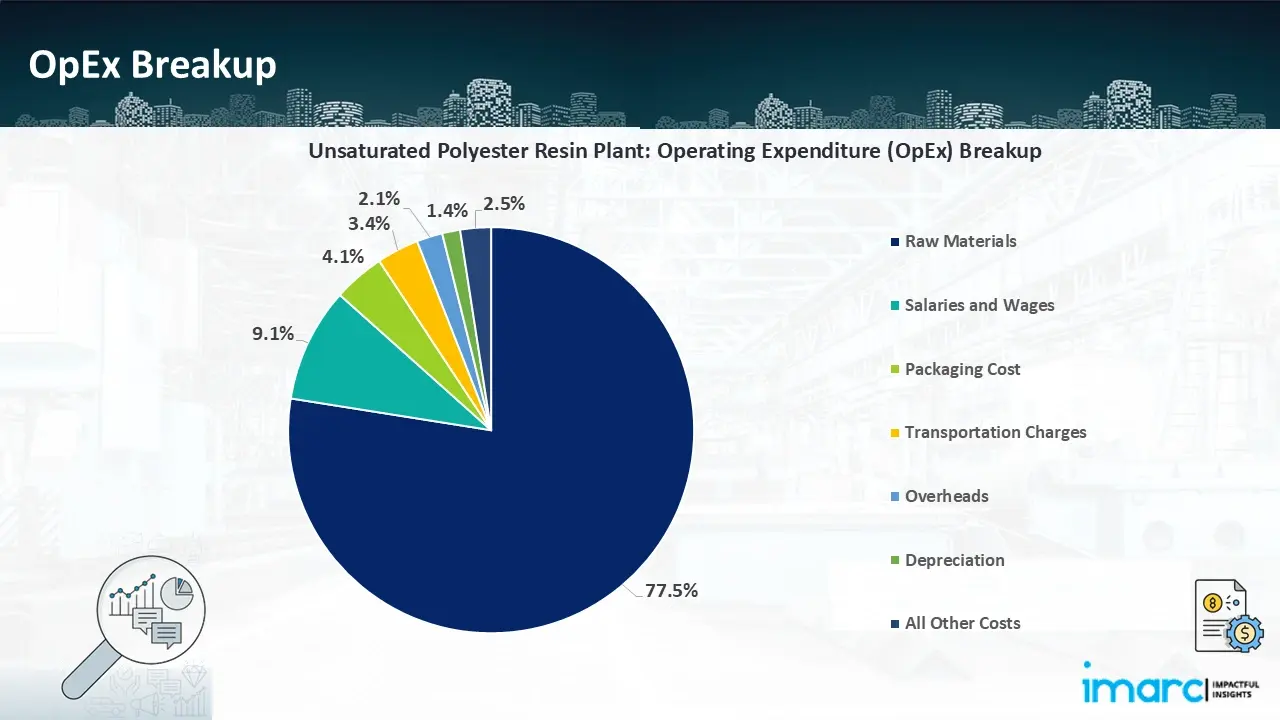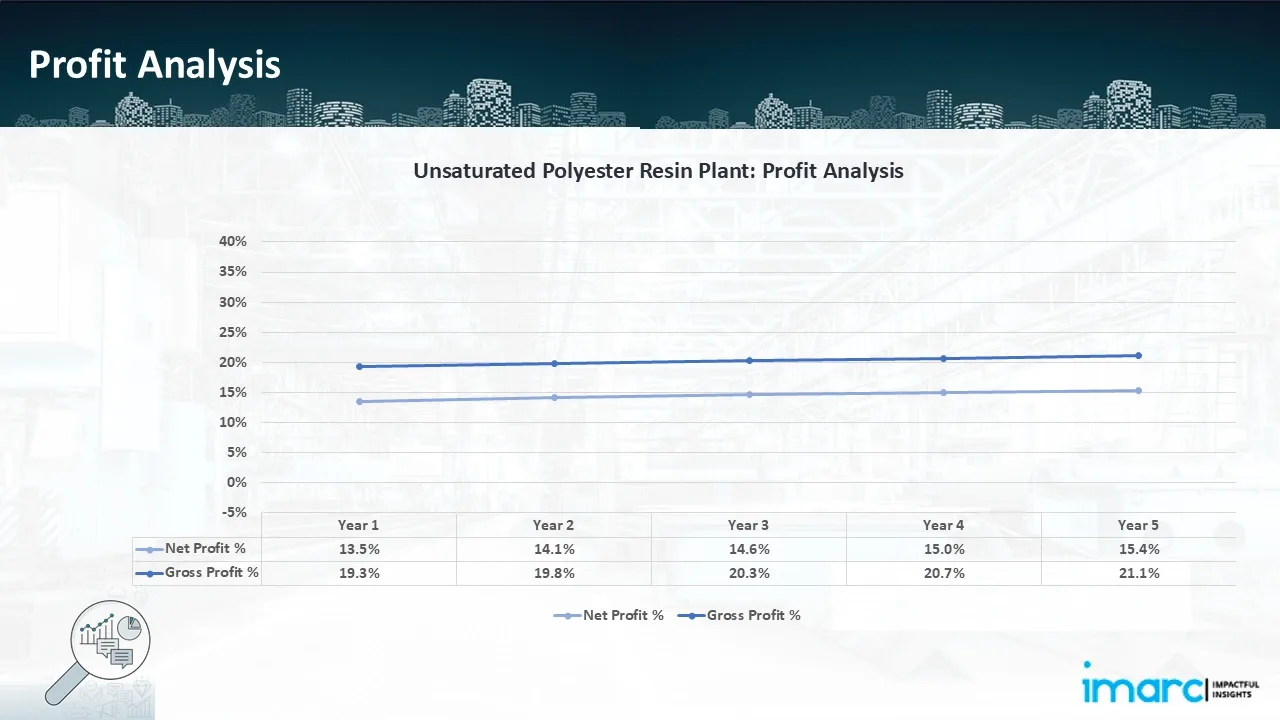Cost Projection and Analysis for Unsaturated Polyester Resin Production: An Elaborate Cost Analysis

What is Unsaturated Polyester Resin?
Widely recognized for its superior mechanical, chemical, and thermal properties, unsaturated polyester resin (UPR) is a highly versatile thermosetting polymer utilized across multiple industries.
Key Applications Across Industries:
UPR is created when unsaturated acids and glycols react mostly used in composites, coatings, and adhesives. It provides durability, resistance to corrosion, and versatility for a range of uses in the automotive, maritime, and construction industries.
What the Expert Says: Market Overview & Growth Drivers
According to an IMARC study, the global unsaturated polyester resin market was valued at USD 13.9 Billion in 2024. Looking ahead, the market is expected to grow at a CAGR of approximately 4.81% from 2025 to 2033, reaching a projected value of USD 21.4 Billion by 2033. The market's growth is primarily driven by the rapid urbanization occurring worldwide, alongside notable expansion in the construction industry.
A variety of products, such as concrete rebars, forming pans, building panels, doors, electrical boxes, and floor grafting, all incorporate UPRs. The maritime industry is another use for these resins, which is contributing to the market's expansion. The expanding use of products in the chemical industry for manufacturing adhesives, castings, composites, flooring materials, gel coatings, and pigment pastes is contributing to market growth. Additionally, several factors are expected to drive the market in the coming years, including the rising demand for nonreinforced cross-linked UPRs in automotive repair component production and ongoing research and development (R&D) efforts aimed at improving the physical properties of these resins.
Case Study on Cost Model of Unsaturated Polyester Resin Manufacturing Plant:
Objective
One of our clients has approached us to conduct a feasibility study for establishing a mid to large-scale unsaturated polyester resin manufacturing plant in Malaysia.
IMARC Approach: Comprehensive Financial Feasibility
We have developed a detailed financial model for the plant's setup and operations. The proposed facility is designed with an annual production capacity of 2,400 tons of unsaturated polyester resin.
Manufacturing Process: Unsaturated polyester resin (UPR) is manufactured using a few crucial stages. Polyhydric alcohols like propylene glycol and unsaturated acids or anhydrides like fumaric acid or maleic anhydride are added to a reaction vessel to start the process. The esterification reaction is started by heating these basic ingredients to about 150°C while stirring them. Water is produced as a byproduct at this stage and eliminated to propel the reaction. To stabilise the intermediate reaction mass, the mixture is cooled to about 60°C after the first reaction is finished. The reaction mass is then heated to a higher temperature—typically between 200°C and 210°C—and stirred some more. By completing the polymerisation process, this stage guarantees the production of a viscous unsaturated polyester resin with the required molecular weight and characteristics. After cooling, the product is modified for uses by adding styrene monomer or other chemicals to reach the necessary reactivity and viscosity. Because of its superior mechanical and chemical qualities, the resulting unsaturated polyester resin is used extensively in composites, coatings, and adhesives in the construction, automotive, and marine industries. It is filtered, stored, and packed for usage in these sectors.
.webp)
Get a Tailored Feasibility Report for Your Project Request Sample
Mass Balance and Raw Material Required: The primary raw materials utilized in the unsaturated polyester resin manufacturing plant include ethylene glycol, phthalic acid anhydride, maleic anhydride, and styrene. To produce 1 ton of unsaturated polyester resin, the raw material requirements are as follows: ethylene glycol (0.29 ton), phthalic acid anhydride (0.25 ton), maleic anhydride (0.15 ton), and styrene (0.37 ton).
List of Machinery
The following equipment was required for the proposed plant:
- Reaction Vessel (1000 L)
- Reaction Vessel (1500 L)
- Reaction Vessel (3000 L)
- Mixing Vessel (1500 L)
- Mixing Vessel (2500 L)
- Mixing Vessel (5000 L)
- Condensation System
- Vaccum system
- Cooling Tower
- Equipment fixation
- Pipeline
- Control Cabinet & Wires
- Delivery Pump & Filtration System
Techno-Commercial Parameter:
- Capital Investment (CapEx): Capital expenditure (CapEx) in a manufacturing plant includes various investments essential for its setup and long-term operations. It covers machinery and equipment costs, including procurement, installation, and commissioning. Civil works expenses involve land development, factory construction, and infrastructure setup. Utilities such as power, water supply, and HVAC systems are also significant. Additionally, material handling systems, automation, environmental compliance, and safety measures are key components. Other expenditures include IT infrastructure, security systems, and office essentials, ensuring operational efficiency and business growth.
- Operating Expenditure (OpEx): Operating expenditure is the cost incurred to operate a manufacturing plant effectively. OpEx in a manufacturing plant typically includes the cost of raw materials, utilities, depreciation, taxes, packing cost, transportation cost, and repairs and maintenance. The operating expenses are part of the cost structure of a manufacturing plant and have a significant effect on profitability and efficiency. Effective control of these costs is necessary for maintaining competitiveness and growth.

- Profitability Analysis Year on Year Basis: The proposed unsaturated polyester resin plant, with a capacity of 2,400 tons per annum, achieved an impressive revenue of US$ 2.98 million in its first year. We assisted our client in developing a detailed cost model, which projects steady growth, with revenue rising throughout the projected period. Moreover, gross profit improved from 19.3% to 21.1%, and net profit rise from 13.5% to a positive 15.4%, highlighting strong financial viability and operational efficiency.

Conclusion & IMARC's Impact:
Our financial model for the unsaturated polyester resin manufacturing plant was meticulously designed to meet the client’s objectives. It provided a thorough analysis of production costs, including raw materials, manufacturing processes, capital expenditure, and operational expenses. Tailored to the specific requirement of producing 2,400 tons of unsaturated polyester resin annually, the model highlights key cost drivers and forecasts profitability, considering market trends, inflation, and potential fluctuations in raw material prices. This comprehensive financial model offers the client valuable insights for strategic decision-making, demonstrating our commitment to delivering precise, client-focused solutions that ensure the long-term success of large-scale manufacturing projects.
Latest News and Developments:
- In November 2024, BASF recently formally opened a new water-based dispersions production line in Heerenveen, the Netherlands, , expanding production capacity without adding to CO2 emissions by utilising the existing buildings and infrastructure.
- In October 2024, A bio-based resin for composite manufacturing was introduced by Exel Composites in partnership with INEOS. The new resin contributes to a lower carbon footprint in the production of composites by reducing dependency on fossil fuels using renewable raw resources. This innovation is a component of Exel's sustainability strategy, which aims to enhance environmental performance without sacrificing the durability or strength of materials.
- In January 2024, the production of Viatel bioresorbable polymers at Ashland's Mullingar facility saw the completion of its second capacity increase. In medical applications, the expansion satisfies the increasing need for bioresorbable polymers worldwide, especially for implantable medical devices and controlled drug delivery. Ashland's capacity to provide cutting-edge materials solutions specifically suited for the pharmaceutical and healthcare industries is improved by this investment.
- In April 2023, AOC, a global provider of gel coatings and resins, and Büfa Composite Systems announced an extended collaboration to fortify their European distribution network. Büfa will provide wider availability by distributing AOC's gel coatings and resin systems to new areas. Delivering premium unsaturated polyester resins and associated composite materials to the building and industrial sectors will be the main objective.
Why Choose IMARC:
IMARC's Financial Model Expertise: Helping Our Clients Explore Industry Economics
IMARC is a global market research company that offers a wide range of services, including market entry and expansion, market entry and opportunity assessment, competitive intelligence and benchmarking, procurement research, pricing and cost research, regulatory approvals and licensing, factory setup, factory auditing, company incorporation, incubation services, recruitment services, and marketing and sales.
Brief List of Our Services: Market Entry and Expansion
- Market Entry and Opportunity Assessment
- Competitive Intelligence and Benchmarking
- Procurement Research
- Pricing and Cost Research
- Sourcing
- Distribution Partner Identification
- Contract Manufacturer Identification
- Regulatory Approvals, and Licensing
- Factory Setup
- Factory Auditing
- Company Incorporation
- Incubation Services
- Recruitment Services
- Marketing and Sales
Under our factory setup services, we assist our clients in exploring the feasibility of their plants by providing comprehensive financial modeling. Additionally, we offer end-to-end consultation for setting up a plant in India or abroad. Our financial modeling includes an analysis of capital expenditure (CapEx) required to establish the manufacturing facility, covering costs such as land acquisition, building infrastructure, purchasing high-tech production equipment, and installation. Furthermore, the layout and design of the factory significantly influence operational efficiency, energy consumption, and labor productivity, all of which impact long-term operational expenditure (OpEx). So, every parameter is covered in the analysis.
At IMARC, we leverage our comprehensive market research expertise to support companies in every aspect of their business journey, from market entry and expansion to operational efficiency and innovation. By integrating our factory setup services with our deep knowledge of industry dynamics, we empower our clients to not only establish manufacturing facilities but also strategically position themselves in highly competitive markets. Our financial modeling and end-to-end consultation services ensure that clients can explore the feasibility of their plant setups while also gaining insights into competitors' strategies, technological advancements, and regulatory landscapes. This holistic approach enables our clients to make informed decisions, optimize their operations, and align with sustainable practices, ultimately driving long-term success and growth.
Our Clients
Contact Us
Have a question or need assistance?
Please complete the form with your inquiry or reach out to us at
Phone Number
+91-120-433-0800+1-201-971-6302
+44-753-714-6104











